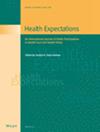Perceptions and Attitudes of People With Cancer and Diabetes Towards Patient Guidelines: A Mixed Methods Study
Abstract
Objective
To explore patients' perceptions and attitudes towards patient guidelines (PGs) and to identify specific factors related to PG content, design, presentation, and management that may influence patients' use or adoption of PGs.
Methods
An exploratory sequential mixed-methods design was employed. Initial semi-structured interviews were conducted with a diverse group of individuals, including people with diabetes or oncology, and clinicians. These interviews were analysed through directed content analysis. Findings from the qualitative study were used to develop a questionnaire. The questionnaire was circulated to patients with diabetes and cancer and asked them to report their awareness, attitudes, and the PG-related factors influencing their use and adoption of PGs.
Results
In total, 25 participants were interviewed qualitatively, and 400 participated in the quantitative survey. Analysis of interviews yielded three themes: perception of PGs, attitude towards PGs, and key PG attributes influencing patients' use or adoption of PG. Qualitative findings indicated limited awareness of PGs, supported quantitatively by only 26.5% of patients being aware of PGs. Attitudes varied, with 73.0% expressing an overall positive attitude towards PG, but only 17.3% preferred PGs for evidence-based answers and 32.3% favoured them for decision support, citing concerns that general recommendations may not meet individual needs. Participants suggested tailoring recommendations based on subgroups considering age, comorbidity, and weight, explaining why treatments work or don't work in different populations. Eight PG attributes influencing their use or adoption were found: accessibility, identifiability, attractiveness, credibility, usability, timeliness, relevance and simplicity. Lack of credibility was the most frequently mentioned hindrance, with 34.8% identifying unverifiable information as a barrier. Further qualitative and quantitative analyses revealed that medical staff were trusted sources for conveying PGs to patients.
Conclusions and Practice Implications
This study underscores the necessity for PGs to acknowledge individual differences and provide recommendations that are more tailored considering age, comorbidities, weight, and other factors influencing decision-making, ensuring that they address patients' specific needs and support informed decision-making. Additionally, there was a significant need to improve the dissemination of PGs, using medical staff as key channels to improve patients' use or adoption of PGs.
Patient or Public Contribution
In this study, patients were actively involved in several stages. During the development of the interview guide, feedback from two patients, alongside one patient guidelines (PGs) developer and three clinicians, was incorporated to ensure the guide's relevance and comprehensiveness. Patients' insights were integral to refining the interview questions, ensuring they were appropriate and effective. Additionally, the survey questionnaire was pre-tested among 20 patients using the Think-Aloud method, which led to significant revisions for better comprehension and response quality. These steps highlight the essential role of patients in shaping the data collection instruments and enhancing the overall quality and relevance of the study.

 求助内容:
求助内容: 应助结果提醒方式:
应助结果提醒方式:


